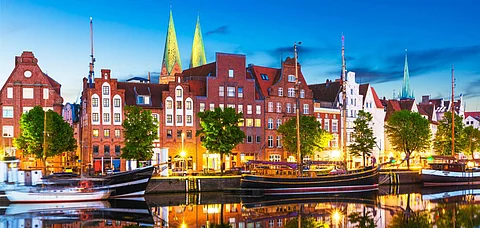
- Destinations
- Experiences
- Stay
- What's new
- Editor’s Picks
- Responsible Tourism
- CampaignsCampaigns
- Subscribe

Lubeck is a city that is intrinsic to a major part of the German history. There are a few places in this Hanseatic city that have stood as witnesses of its splendour over time. Ranging from the salt store houses, the Brick gothic gate of the Hanseatic city, an old railway station and a church symbolic of the city&rsquos prosperity, Lubeck is abundant in landmark locations that have a rich history. Here are 6 note-worthy things that help Lubeck exude an old world charm
Salt Store House
Also known as the Salzspeicher, the salt store house of Lubeck is a set of six brick buildings on the upper end of the Trave River. These 16th-18th century houses were used to store salt that was mined near Luneburg, hence deriving their name as salt store houses. Lubeck was powerful during the Middle Ages for a lot of reasons, one of which was its superiority in the salt trade. Later on, these brick houses were used as stores for other commodities like grain, cloth, etc. The salt storehouses of Lubeck are an important chapter in the hanseatic city&rsquos history.
Holsten Gate
A visual landmark of the Hanseatic city of Lubeck, the Holsten Gate is one of the reasons for Lubeck&rsquos Unesco World Heritage site designation. This city gate dates back to the year 1464 and marks the western boundary of the old center of Lubeck. It is a fine Brick Gothic structure standing tall with its two round conical roof towers and an arched entrance. The Holsten Gate building has four floors, and appears as a unified structure when viewed from the city side. With two terracotta stripes encircling the building and interiors that serve as a museum, attracting history enthusiasts, the Holsten Gate is a must visit in Germany.
Lubeck Hauptbahnhof
This is the main railways station of Lubeck and the busiest one of all railway stations in Schleswig-Holstein. A category 2 station, Lubeck Hauptbahnhof has a reception building spanning over four platforms. This station was initially constructed in the year 1908 and was demolished in 1934. The reconstruction later resulted in the present shape of the Lubeck Hauptbahnhof. The Lubeck railway station is a significant landmark of the Hanseatic city.
St Mary&rsquos Church
A motif of Lubeck&rsquos prosperity as an old city, the St. Mary&rsquos Church is an old building placed at the highest point of the island. Another specimen of Gothic era architecture, this church inspired the design of several other churches. Side chapels, magnificent westwork and weather vanes define this significant building of the Hanseatic city. When visiting St. Mary&rsquos in Lubeck, you can witness a restored Darsow Madonna from 1420, sandstone reliefs, remains of the Antwerp altarpiece which dates back to 1518 and several other transcendent bronze structures.
Trave River
Running across a length of 124 kilometres, the Trave River in Schleswig-Holstein is a navigable river. The Trave is a significant part of the town&rsquos history. It forms part of Lubeck&rsquos medieval fortifications. The region surrounding this river is a &lsquoflora and fauna habitat&rsquo as designated by the European Union Habitats Directive. While holding a historical and cultural significance, Trave is a natural spectacle for the visitors. The surrounding region is also an area where one can enjoy hiking, cycling and fishing. The river is also home to some strikingly unique underwater species.
Old houses and buildings
This charming old city was first set in the Neolithic Era, but the modern town started taking shape around 1143. While standing witness to World War bombing and excessive damage, the city was renovated and recreated later on. With its seven churches, buildings reminiscent of Romanesque style of architecture and influence of the Gothic era, Lubeck is a canvas of abbeys, old houses, salt storehouses and narrow lanes that connect them all. Declared a UNESCO Heritage Site in 1987, this city is rich in the hues of history and architecture.
This is a sponsored post in collaboration with German National Tourist Office, India.
